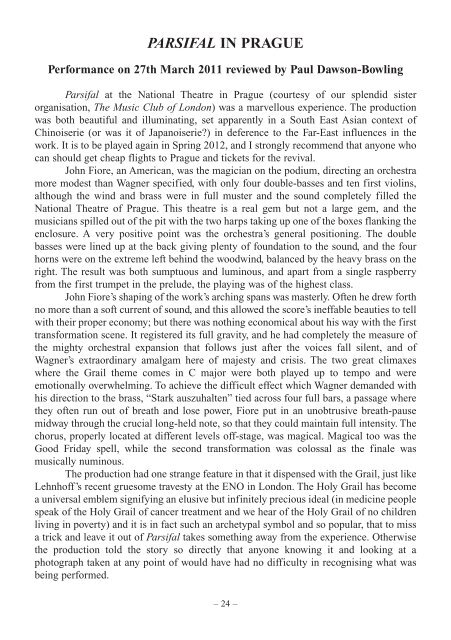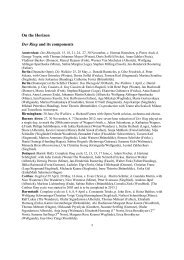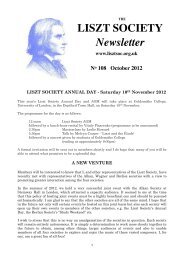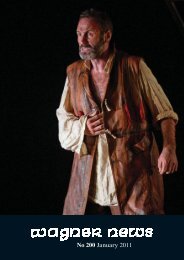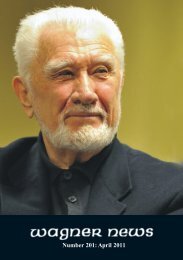Number 202: July 2011 - Wagner Society of England
Number 202: July 2011 - Wagner Society of England
Number 202: July 2011 - Wagner Society of England
Create successful ePaper yourself
Turn your PDF publications into a flip-book with our unique Google optimized e-Paper software.
PARSIFAL IN PRAGUE<br />
Performance on 27th March <strong>2011</strong> reviewed by Paul Dawson-Bowling<br />
Parsifal at the National Theatre in Prague (courtesy <strong>of</strong> our splendid sister<br />
organisation, The Music Club <strong>of</strong> London) was a marvellous experience. The production<br />
was both beautiful and illuminating, set apparently in a South East Asian context <strong>of</strong><br />
Chinoiserie (or was it <strong>of</strong> Japanoiserie?) in deference to the Far-East influences in the<br />
work. It is to be played again in Spring 2012, and I strongly recommend that anyone who<br />
can should get cheap flights to Prague and tickets for the revival.<br />
John Fiore, an American, was the magician on the podium, directing an orchestra<br />
more modest than <strong>Wagner</strong> specified, with only four double-basses and ten first violins,<br />
although the wind and brass were in full muster and the sound completely filled the<br />
National Theatre <strong>of</strong> Prague. This theatre is a real gem but not a large gem, and the<br />
musicians spilled out <strong>of</strong> the pit with the two harps taking up one <strong>of</strong> the boxes flanking the<br />
enclosure. A very positive point was the orchestra’s general positioning. The double<br />
basses were lined up at the back giving plenty <strong>of</strong> foundation to the sound, and the four<br />
horns were on the extreme left behind the woodwind, balanced by the heavy brass on the<br />
right. The result was both sumptuous and luminous, and apart from a single raspberry<br />
from the first trumpet in the prelude, the playing was <strong>of</strong> the highest class.<br />
John Fiore’s shaping <strong>of</strong> the work’s arching spans was masterly. Often he drew forth<br />
no more than a s<strong>of</strong>t current <strong>of</strong> sound, and this allowed the score’s ineffable beauties to tell<br />
with their proper economy; but there was nothing economical about his way with the first<br />
transformation scene. It registered its full gravity, and he had completely the measure <strong>of</strong><br />
the mighty orchestral expansion that follows just after the voices fall silent, and <strong>of</strong><br />
<strong>Wagner</strong>’s extraordinary amalgam here <strong>of</strong> majesty and crisis. The two great climaxes<br />
where the Grail theme comes in C major were both played up to tempo and were<br />
emotionally overwhelming. To achieve the difficult effect which <strong>Wagner</strong> demanded with<br />
his direction to the brass, “Stark auszuhalten” tied across four full bars, a passage where<br />
they <strong>of</strong>ten run out <strong>of</strong> breath and lose power, Fiore put in an unobtrusive breath-pause<br />
midway through the crucial long-held note, so that they could maintain full intensity. The<br />
chorus, properly located at different levels <strong>of</strong>f-stage, was magical. Magical too was the<br />
Good Friday spell, while the second transformation was colossal as the finale was<br />
musically numinous.<br />
The production had one strange feature in that it dispensed with the Grail, just like<br />
Lehnh<strong>of</strong>f’s recent gruesome travesty at the ENO in London. The Holy Grail has become<br />
a universal emblem signifying an elusive but infinitely precious ideal (in medicine people<br />
speak <strong>of</strong> the Holy Grail <strong>of</strong> cancer treatment and we hear <strong>of</strong> the Holy Grail <strong>of</strong> no children<br />
living in poverty) and it is in fact such an archetypal symbol and so popular, that to miss<br />
a trick and leave it out <strong>of</strong> Parsifal takes something away from the experience. Otherwise<br />
the production told the story so directly that anyone knowing it and looking at a<br />
photograph taken at any point <strong>of</strong> would have had no difficulty in recognising what was<br />
being performed.<br />
– 24 –


